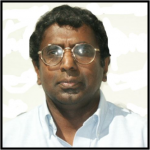Gayanath W Fernando
Professor
Physics
Research Interests
Understanding properties of materials using fundamental principles of quantum mechanics has played a key role in the technological advances that have transformed the living standards of the human race. One important example is the transistor, discovered in 1947 at Bell labs, that is a vital building block of modern electronics and integrated circuits used in computers, televisions and mobile phones. More recently, new magnetic materials, high temperature superconductors and nanomaterials have found important applications in medical and other sciences. Without basic research in condensed matter physics, none of the above advances would have been possible.
I have been engaged in first principles and other (both formal and computational) approaches to electronic, magnetic and structural properties of condensed matter systems for several decades. Some of this early work has appeared in a book on “Metallic Multilayers and their Applications” authored by me and published by Elsevier in 2008. My current research interests include materials with strongly correlated electrons, exact calculations of correlated nanoclusters, high temperature superconductivity, magnetism, topological materials and various symmetry breaking mechanisms in condensed matter systems including quasi two-dimensional organic materials.
My most recent work includes time dependent (floquet-type) single and many electron systems. By using time-periodic external fields, it is possible to tune their physical properties.
Four recent publications:
Driven emergent phases in small interacting condensed-matter systems, Gayanath W. Fernando, R. Matthias Geilhufe, Adil-Gerai Kussow and W. Wasanthi P. De Silva
, , 37004 (2021).
Chemical-strain induced tilted Dirac nodes in (BEDT-TTF)2 X3 (X=I, Cl, Br, F) based charge transfer salts, R. M. Geilhufe, B. Commeau and G. W Fernando, Physica Status Solidi, 1800081 (2018).
Structural and electronic properties of alpha-(BEDT-TTF)2I3, beta-(BEDT-TTF)2I3 and kappa-(BEDT-TTF)2X3 (X=I,F,Br,Cl) organic charge transfer salts,
B. Commeau, R. M. Geilhufe, G. W. Fernando, and A. V. Balatsky, Physical Review B 96, 125135 (2017).
From a Z2 topological insulator to a square ribbon: Tuning
quantum spin Hall states and conductivity, Zhiwei Zhang, Yiteng Tang, and Gayanath Fernando,
Journal of Applied Physics, 121, Issue 20, 204302 (2017).
My teaching interests include condensed matter physics, quantum mechanics, many-body theory, classical and statistical mechanics and mathematical methods in physics. I am also interested in improving the technical (math and physics) skills of STEM students and currently working on a related book to be published by World Scientific.
Education
- Ph.D., Physics, Cornell University, 1985
- M.S., Physics, Cornell University, 1982
- B.S., Mathematics, University of Colombo, Sri Lanka, 1978
Experience
- 1991-present: Professor, Department of Physics, University of Connecticut
- 1987-1991: Scientist, Department of Physics, Brookhaven National Laboratory
- 1984-1986: Postdoctoral Fellow, Department of Physics, West Virginia University
Professional Societies
- American Physical Society
- Sigma-Pi-Sigma

| gayanath.fernando@uconn.edu | |
| Phone | (860)486-0442 |
| Fax | (860)486-3346 |
| CV | gwf_vita_22 |
| Mailing Address | Dept. of Physics, University of Connecticut unit 3046, 196 Auditorium Road, Storrs, CT 06269-3046 |
| Office Location | S213D |
| Campus | Storrs |
| Link | http://www.phys.uconn.edu/~fernando/ |